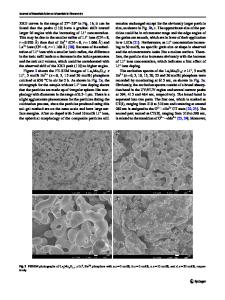A Novel Tick Film Nanocrystalline Y 2 O 3 :Eu 3+ Phosphor Synthesized by Post-Dispersion Treatment at Low Temperature
- PDF / 512,878 Bytes
- 6 Pages / 612 x 792 pts (letter) Page_size
- 100 Downloads / 338 Views
N3.25.1
A Novel Tick Film Nanocrystalline Y2O3:Eu3+ Phosphor Synthesized by Post-Dispersion Treatment at Low Temperature Sung-Jei Hong, Min-Gi Kwak, Dae-Gyu Moon, Won-Keun Kim, and Jeong-In Han Information Display Research Center, Korea Electronics Technology Institute #455-6, MaSan, JinWi, PyungTack, KyungGi, 451-865, Korea ABSTRACT In this study, a novel thick film nanocrystalline phosphor is synthesized by using postdispersion treatment at low temperature. The post-dispersion treatment is to prevent the agglomeration between the precursors by mixing the organic dispersing agent with them before heat-treatment. The mean size of the particle heat-treated at 500oC is 4nm. Also, europium is uniformly distributed in the yttrium oxide with deviation below 0.5%. The nanocrystalline phosphor is principally composed of cubic structure having preferred orientation of , , and . The photoluminescence properties of the nanocrystalline phosphor characterized with monochrometric systems reveals that the main PL peak is detected at 611 nm, and thick film nanocrystalline phosphor with 15wt% europium exhibits better properties. INTRODUCTION A nanocrystalline phosphor improves optical properties by controlling the recombination behavior between electron and hole efficiently. The phenomenon is achieved from the ultrafine size effect owing to the change of energy level by restricting the electron and hole [1]. However, particle size of nanocrystalline phosphor increases easily under even the small changes of heattreating temperature because the wider surface is very unstable and tends to reduce the surface area [2, 3]. The increase of particle size gives rise to a reduction of the surface area of the nanoprticles inevitably, and the optical properties of nanocrystalline phosphor come to be degraded. In this study, we attempt to prevent the agglomeration of the nanocrystalline phosphor by mixing the precursor nanoparticle with organic solvent before heat-treatment. The attempted process is called as post-dispersion process.
N3.25.2
EXPERIMENTAL DETAILS Yttrium acetylacetonate and europium acetate are used as raw materials. To synthesize the thick film, YxOy:Eu3+ precursors with various concentration of europium are prepared. Then, post-dispersion treatment of the precursors is done under low temperature. Synthesized precursor nanoparticles are dispersed into organic solvent to block one nanoparitcle from others. The mixture of the precursor and the organic dispersing agent is printed and heat-treated on silicon wafer. Thermal analyses such as differential thermal analysis (DTA) and thermogravimetric analysis (TGA) of the precursor dispersed into organic solvent are done to determine the minimal limit of heat-treating temperature. Then, we attempt to optimize the size of the nanocrystalline phosphor by varying temperature of the post treatment ranging from 500oC to 900oC. The fabricated thick films of nanocrystalline phosphors are investigated by analyzing the size and crystal structure with high resolution transmission electron mi
Data Loading...











